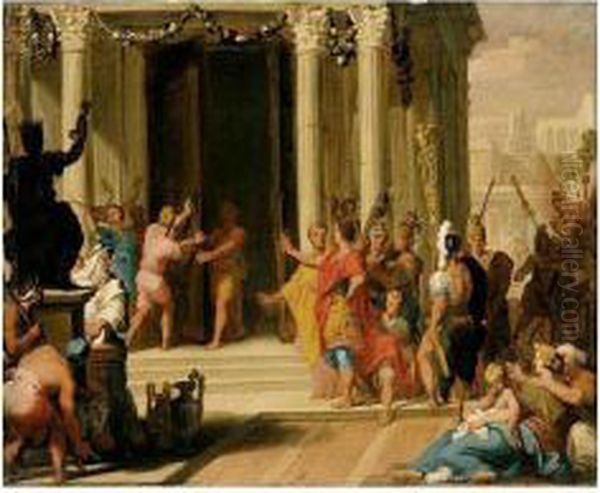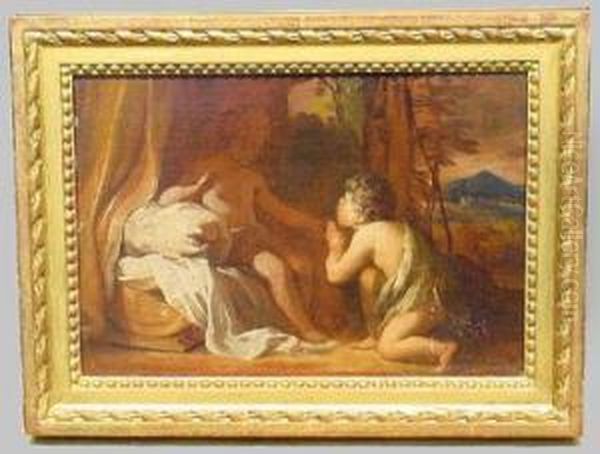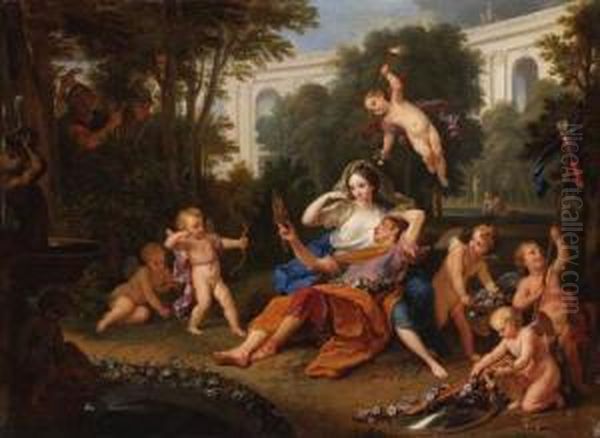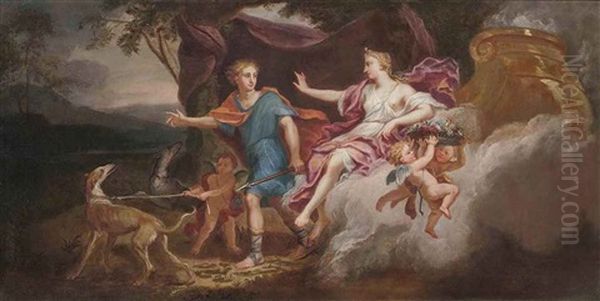Louis de Boulogne the Younger (1654-1733) stands as a significant figure in the annals of French art, a painter whose career bridged the late Baroque grandeur of Louis XIV's reign with the emerging Rococo sensibilities of the early 18th century. Born into an esteemed artistic dynasty in Paris, he not only inherited a rich legacy but also carved out his own distinct path, culminating in the highest accolades available to an artist in France. His work, characterized by its elegance, technical finesse, and adherence to academic principles, adorned royal palaces and influential Parisian buildings, leaving an indelible mark on the artistic landscape of his time.
An Auspicious Beginning: The Boullogne Artistic Heritage
Louis de Boulogne the Younger, often referred to as Louis le Jeune to distinguish him from his father, was born in Paris in 1654. His father, Louis de Boullogne the Elder (c. 1609–1674), was a respected painter and one of the founding members of the prestigious Royal Academy of Painting and Sculpture (Académie Royale de Peinture et de Sculpture). This familial connection provided young Louis with an immersive artistic environment from his earliest years. His elder brother, Bon Boullogne (1649–1717), also became a notable painter and a professor at the Academy, further solidifying the family's artistic prominence.
Growing up in such a household, Louis the Younger was steeped in the theories and practices of art. He received his foundational training from his father, absorbing the classical principles that were the bedrock of French academic art. The competitive yet supportive atmosphere, with both his father and brother actively engaged in the Parisian art world, undoubtedly spurred his development. This early exposure and rigorous training laid the groundwork for a career that would see him rise to the zenith of the French art establishment.

At the remarkably young age of eighteen, around 1672, Louis de Boulogne the Younger demonstrated his prodigious talent by winning the coveted Prix de Rome from the Royal Academy. This prestigious award, highly sought after by aspiring artists, provided a scholarship for several years of study at the French Academy in Rome. This achievement was a testament to his early mastery of composition, drawing, and painting, and it marked the beginning of a crucial phase in his artistic development.
The Roman Sojourn: Immersion in Classical and Renaissance Ideals
In 1675, Louis de Boulogne the Younger embarked on his journey to Rome, the epicenter of classical antiquity and Renaissance mastery. The years spent in Italy were transformative for any artist, offering unparalleled opportunities to study firsthand the works of the great masters. For Boullogne, this period was instrumental in refining his style and broadening his artistic horizons. He dedicated himself to the meticulous study and copying of masterpieces, a traditional academic practice designed to instill an understanding of form, composition, and technique.
His primary focus was on the works of Raphael Sanzio (1483-1520), particularly the monumental frescoes in the Vatican Stanze. Boullogne produced highly acclaimed copies of Raphael's The School of Athens and the Disputation of the Holy Sacrament. These copies were not mere imitations but were considered insightful interpretations that captured the spirit and grandeur of the originals. His skill in rendering these complex compositions earned him considerable recognition and enhanced his reputation even before his return to France. He also reportedly copied Raphael's Lamentation over the Dead Christ.
Beyond Raphael, Boullogne immersed himself in the broader Italian artistic tradition. He studied the works of other High Renaissance masters like Correggio (1489-1534) and the Bolognese school, including the Carracci family – Annibale (1560-1609), Agostino (1557-1602), and Ludovico (1555-1619) – whose emphasis on drawing and classical forms resonated with French academic ideals. He also absorbed the lessons of Roman Baroque painting and reportedly spent time in Venice, where he would have encountered the rich colorism of Venetian masters like Titian (c. 1488/1490–1576) and Veronese (1528-1588), which likely influenced his palette.
Return to Paris and Ascent in the Royal Academy
Louis de Boulogne the Younger returned to Paris around 1680, his skills honed and his reputation enhanced by his Roman studies. He quickly established himself within the Parisian art scene. In 1681, he was received (agréé) into the Royal Academy of Painting and Sculpture, presenting Augustus Orders the Closing of the Temple of Janus (now in the Musée des Beaux-Arts d'Amiens) as his reception piece. This marked his official entry into the institution that would become central to his career.

The following decades saw a steady rise in his stature. He received numerous commissions for religious paintings for churches in Paris, such as for Notre-Dame Cathedral and the Church of Saint-Sulpice, and for decorative schemes in royal and private residences. His involvement in the extensive decorative projects at the Palace of Versailles, under the artistic direction of Charles Le Brun (1619-1690) and later Jules Hardouin-Mansart (1646-1708), was particularly significant. He contributed to the Salon de Mars and the Chapel Royal, among other spaces, demonstrating his versatility in handling large-scale allegorical and religious subjects.
His dedication to the Academy was unwavering. He became a professor, actively involved in teaching and upholding its doctrines. His career within the Academy culminated in a series of prestigious appointments: in 1722, he was named "Directeur" (Director) of the Academy. In 1723, he became the Rector. His service and artistic merit were further recognized when, in 1725, he was ennobled and appointed Premier Peintre du Roi (First Painter to the King) by Louis XV, succeeding Antoine Coypel (1661-1722) in this esteemed role. This was the highest official artistic position in France, placing him at the head of the artistic establishment. He also became Director of the Royal Academy in the same year, a role he held until his death.
Artistic Style and Thematic Concerns
Louis de Boulogne the Younger's artistic style is best described as a refined classicism, infused with a grace and elegance that foreshadowed the Rococo. His work embodies the academic ideals of clarity, balance, and decorum, yet it possesses a distinctive softness and fluidity. His drawing was precise and assured, his compositions well-ordered, and his figures often imbued with a gentle, sometimes melancholic, expressiveness.
His palette tended towards harmonious and often lighter tones compared to the more dramatic chiaroscuro of some of his Baroque predecessors or even his own father, whose earlier works showed a Caravaggesque influence. Louis the Younger's handling of paint was smooth and polished, with "delicate lines and elegant brushwork," creating a sense of refined fluidity. This contrasted with the more robust and color-driven style of his brother, Bon Boullogne, or the more overtly dramatic compositions of contemporaries like Jean Jouvenet (1644-1717).

Boullogne excelled in religious and mythological subjects, the mainstays of academic history painting. His religious works, such as Christ and the Woman with an Issue of Blood (1695, Musée Carnavalet, Paris) or The Presentation in the Temple (Musée du Louvre, Paris), are characterized by their dignified piety and clear narrative. His mythological paintings, often created for decorative ensembles, depict gods and goddesses with an elegant sensuality, as seen in works like Diana Resting After the Hunt or Venus and Adonis. He also produced portraits, though these are less central to his oeuvre.
His deep understanding of classical art, particularly the legacy of Raphael, remained a constant touchstone. However, his style evolved, absorbing the changing tastes of the late 17th and early 18th centuries. There is a discernible shift towards a lighter, more graceful manner in his later works, aligning with the nascent Rococo aesthetic championed by artists like Antoine Watteau (1684-1721), though Boullogne always remained more firmly rooted in the classical tradition.
Major Works and Commissions
Throughout his long and productive career, Louis de Boulogne the Younger executed a significant body of work. His copies after Raphael, made during his time in Rome, were foundational and remained highly regarded. These include:
The School of Athens
The Disputation of the Holy Sacrament
The Parnassus
The Fire in the Borgo
The Lamentation over the Dead Christ
Upon his return to Paris, his commissions were numerous:
Versailles: He contributed significantly to the decoration of the Palace of Versailles. His works can be found in the Grand Apartments, such as paintings in the Salon de Mars, and notably in the Chapel Royal, where he painted The Healing of the Paralytic and The Entry of Christ into Jerusalem in the vaults. He also worked on decorations for the Château de Meudon and the Château de Trianon.
Parisian Churches: He was a favored painter for religious commissions. Notable works include paintings for Notre-Dame Cathedral (part of the annual "Mays de Notre-Dame" series), the Church of Saint-Sulpice, and the Church of the Invalides. The Presentation in the Temple (Louvre) and St. Augustine and the Child are examples of his religious output.
Gobelins Tapestry Manufactory: Like many leading academicians, Boullogne provided designs (cartoons) for the prestigious Gobelins tapestry manufactory. His compositions were translated into luxurious textiles that adorned royal and aristocratic interiors. He was involved with designs such as the Story of Esther series. His work here would have brought him into contact with figures like Michel Audran II, who oversaw aspects of tapestry production.
Other Decorative Schemes: He also worked on decorative paintings for private hôtels particuliers in Paris, contributing to the elegant interiors favored by the French elite.

Some specific works often attributed to him or his workshop include:
Christ and the Woman with an Issue of Blood (1695, Musée Carnavalet, Paris)
Apollo and Hyacinthus
Neptune and Amphitrite
The Marriage of Venus and Bacchus
His works are now found in major museum collections, including the Musée du Louvre in Paris, the Palace of Versailles, the Musée des Beaux-Arts de Rouen, the Musée des Beaux-Arts d'Orléans, and the Musée Carnavalet.
The Boullogne Artistic Dynasty: Distinctions and Confusions
The Boullogne family formed a veritable artistic dynasty, with Louis the Elder, Bon, and Louis the Younger all achieving significant recognition. This familial concentration of talent, while beneficial for their individual careers through shared knowledge and connections, has sometimes led to confusion in art historical attributions.
Louis de Boullogne the Elder (c. 1609–1674) was a painter of religious and mythological scenes, influenced by his time in Italy and showing, in some works, a restrained Caravaggism akin to that of artists like Valentin de Boulogne (no direct relation, despite the name) or Nicolas Régnier. His style was generally more robust and darker than that of his son Louis the Younger. Works like The Martyrdom of St. Paul or St. John the Baptist are characteristic of the Elder.
Bon Boullogne (1649–1717), Louis the Younger's elder brother, was also a highly successful painter and professor at the Academy. His style was often more painterly and color-driven than Louis the Younger's, sometimes compared to the Venetian school or even showing an affinity with the rich textures of Peter Paul Rubens (1577-1640). Bon was particularly known for his depictions of mythological scenes and his skill in rendering flesh tones. There was a period around 1680 when Louis the Younger reportedly lived with Bon, and they likely exchanged artistic advice.
The similarity in names and the shared subject matter (religious and mythological themes common to academic painters) have occasionally resulted in works by one Boullogne being misattributed to another. Louis the Younger's more polished, classical, and ultimately more "French" academic style generally distinguishes him from his father's more Italianate Baroque and his brother's more coloristic approach. However, careful connoisseurship is often required. The source material itself shows this confusion, for instance, attributing a Massacre of the Innocents from 1640 (when Louis the Younger was not yet born) and a Virgin Mary influenced by Carlo Saraceni (active mainly in the early 17th century) to "Louis de Boullogne," which would clearly point to Louis the Elder.
Influence, Legacy, and Contemporaries
Louis de Boulogne the Younger's influence extended through several avenues: his own prolific output, his prominent role in the Royal Academy, and his teaching. As Premier Peintre du Roi and Director of the Academy, he was a central figure in shaping artistic taste and policy in France during the early 18th century. He trained numerous students, passing on the academic principles of drawing, composition, and classical ideals. Among his pupils were notable artists such as Charles-Joseph Natoire (1700-1777), who would himself become a leading figure in the Rococo period and Director of the French Academy in Rome.
He was a contemporary of many leading French artists. In his early career, the dominant figure was Charles Le Brun, whose influence shaped the artistic endeavors of Louis XIV's reign. As Le Brun's influence waned after 1683, a new generation of artists, including Boullogne, Charles de La Fosse (1636-1716), Jean Jouvenet, and Antoine Coypel, came to the fore, each contributing to the evolution of the French grand manner. La Fosse, with his Rubeniste tendencies and lighter palette, was particularly influential in the transition towards the Rococo. Jouvenet was known for his powerful religious compositions. Coypel, Boullogne's predecessor as Premier Peintre, also specialized in history painting.
The era also saw the rise of great portraitists like Hyacinthe Rigaud (1659-1743) and Nicolas de Largillière (1656-1746), who captured the likenesses of the French elite. While Boullogne was primarily a history painter, he operated within this vibrant artistic milieu. Later in his career, he witnessed the emergence of Antoine Watteau, François Boucher (1703-1770), and Jean-Honoré Fragonard (1732-1806), who would define the Rococo style. While Boullogne's art remained more conservative, its elegance and refinement provided a bridge from the formal classicism of the Grand Siècle to the lighter graces of the new era. His work at the Gobelins also connected him to designers and craftsmen like Michel Audran II and indirectly to figures like Claude Audran III (1658-1734), Watteau's master, and the animal painter Alexandre-François Desportes (1661-1743), who also supplied designs for tapestries.
His art, though sometimes overshadowed by the more dramatic innovations of others or the more overt charm of the Rococo, was highly esteemed in its time. He successfully navigated the complex world of royal patronage and academic politics, maintaining a reputation for excellence and professionalism. His commitment to the classical tradition, tempered with a refined sensibility, ensured that his work remained influential.
Conclusion: A Pillar of French Academic Art
Louis de Boulogne the Younger died in Paris in 1733, at the age of 79, having enjoyed a long, distinguished, and highly successful career. He was a quintessential academic artist, deeply versed in classical and Renaissance traditions, yet responsive to the evolving tastes of his time. His journey from a promising student winning the Prix de Rome to the esteemed position of Premier Peintre du Roi and Director of the Royal Academy is a testament to his talent, diligence, and dedication.
His numerous paintings for churches, royal palaces, and private collections helped to define the visual culture of late 17th and early 18th-century France. While his name might not be as instantly recognizable today as some of his more revolutionary contemporaries, his contribution to the continuity and development of the French school of painting is undeniable. He upheld the highest standards of craftsmanship and academic principle, influencing a generation of artists and leaving behind a legacy of elegant, accomplished works that continue to be appreciated for their refined beauty and historical significance. Louis de Boulogne the Younger remains a key figure for understanding the transition in French art from the Baroque to the Rococo, a pillar of the academic tradition that shaped European art for centuries.